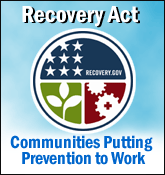Health and Sustainability Guidelines for Federal Concessions and Vending Operations
In 2010, HHS and GSA began a collaboration to create the Health and Sustainability Guidelines for Federal Concessions and Vending Operations. The goal of the Guidelines is to assist contractors in increasing healthy food and beverage choices and sustainable practices at federal worksites.
By applying the 2010 Dietary Guidelines for Americans to food service operations, these Guidelines demonstrate HHS’ and GSA’s commitment to promoting a healthy workforce.
Providing healthy choices
In alignment with the 2010 Dietary Guidelines for Americans, the Health and Sustainability Guidelines support healthier choices, such as
- Seasonal vegetables and fruits.
- Whole grain options, including pasta.
- Vegetarian entrees.
- Lean meat entrees.
- Low-fat milk, yogurt and cottage cheese.
- High fiber, low sugar cereals.
- 100% fruit juice.
- Freely available drinking water.
- Foods with less sodium.
- Foods free of synthetic sources of trans fats.
Enabling sustainable practices
The Health and Sustainability Guidelines also support more sustainable food service practices, such as
- Offering incentives for using reusable beverage containers.
- Using green cleaning and pest control practices.
- Using compostable and bio-based trays, flatware, plates and bowls.
- Offering food that is organically, locally or sustainably grown and labeled accordingly.
- Offering seafood identified as ‘Best Choices’ or ‘Good Alternatives’ on the Monterey Bay Aquarium’s Seafood Watch List or certified by the Marine Stewardship Council (or equivalent program).
Increasing choice, not restricting choice
The Guidelines are designed to make healthy choices more accessible, more appealing, and more affordable. They are not designed to restrict choices.
Applying to all HHS and GSA worksites
The Health and Sustainability Guidelines, which are already in effect at the HHS Humphrey Building Cafeteria, apply to the following:
- Sponsored or co-sponsored conferences.
- All food service concession operations and vending machines managed by HHS and GSA.
- Various events onsite and offsite.
Support for the Guidelines
A diverse array of public health organizations has written letters to Secretary Sebelius offering support for the Health and Sustainability Guidelines. The following statements affirm that the Guidelines make important, needed changes to worksite environments and can serve as a model for state and local governments, businesses, and non-governmental organizations seeking to make healthy choices easier for their employees.
According to the American Diabetes Association, “the healthy food service guidelines represent an important step in preventing type 2 diabetes and its complications by providing healthy fare in federal workplaces and providing information to employees about making healthy choices. With nearly 2 million civilian employees, the federal government has a unique opportunity to influence individuals who may be at risk for type 2 diabetes and its complications, including heart disease, stroke, blindness, amputation and kidney disease.”
The American Public Health Association commends the Guidelines as an “excellent example of implementation strategies for the 2010 Dietary Guidelines for Americans. […]We believe that the guidelines are an important part of obesity prevention making it possible for working Americans to follow recommendations to lower energy intake and increase energy expenditure at vending machines and in cafeterias. The guidelines will also make it easier to eat a diet that protects against heart disease, diabetes, and some forms of cancer by increasing access to foods that are lower in trans fats, sodium, and added sugars. […] The guidelines you have put forth are consistent with our support for a food system that not only protects us against nutrition-related diseases but also protects environmental health and encourages sustainable agricultural practices.”
The California Pan-Ethnic Health Network indicates that “using [the Health and Sustainability] Guidelines as a model, we have sponsored a state bill, AB 727 authored by Assembly Member Holly Mitchell, which would require California to adopt a similar healthy and sustainable food procurement policy. […] Having a comprehensive approach at the national level will fuel our local efforts. While obesity has numerous, complex causes, approaches that make healthy choices available, affordable, and easy are the most effective.”
According to the National Association of Chronic Disease Directors, “the healthy food service guidelines will serve as a model for state agencies in their work to combat obesity through policy and environmental change initiatives promoting health in all environments, including worksites.”
The National Business Coalition on Health “endorses both the processes for the development of this guidance using the best evidence as well as the use of the guidelines. […] The inter-agency approach affords the opportunity to address issues that impact health in a more holistic way and to utilize the expertise across government. The fact that you are using these guidelines in Federal settings clearly shows your commitment to improving the health of Americans by example. […] We expect that employers will use the guidance to help make healthy choices easier for their employees.”
The National Association of Local Boards of Health “strongly believes that these guidelines are an essential addition to the public health field and set a superior example for state and local governments, businesses, and non-governmental agencies to make their food services healthier and more sustainable for their employees. Just as these federal guidelines promote a healthy workforce and work to combat obesity through policy and environmental change, similar guidelines adopted by non-federal agencies will work towards addressing the overweight and obesity concerns for diverse populations in multiple settings. These guidelines are a necessary first step in reducing the obesity epidemic.”
Public Health Law and Policy is “pleased that the guidelines do not restrict choices, but rather increase healthy options so the healthy choice becomes the easy choice for federal employees. Just as there is no single cause of obesity and overweight, there is no single solution. To combat a problem with complex and numerous causes, approaches need to reach people in multiple settings, such as communities, schools, work sites, and health care facilities. Policies like the Guidelines that make healthy choices available, affordable, and easy can only serve to improve the health of our workforce and increase quality of life.”
According to Partnership for Prevention, “efforts to make healthy foods more affordable, more available, and more obvious are essential to helping Americans eat better and improve their health… The healthy food service guidelines are an example of policy and environmental changes and address Dr. Frieden’s ‘winnable battles’ of obesity and nutrition. These guidelines requiring foods to meet the 2010 Dietary Guidelines for Americans should be adopted by other federal agencies, hospitals and in-patient healthcare facilities, childcare facilities, and private sector worksites.”
Prevention Institute “commends HHS and GSA on the inclusion of sustainability criteria in the Guidelines. The health impacts of our food system span far beyond the nutrients contained in food, yet are often overlooked in the development of nutrition guidelines. […] By incorporating sustainability criteria into the Guidelines, HHS is taking an important step towards a more holistic and comprehensive approach to promoting healthful food. Moving forward, we would like to see these guidelines used as a model, and a baseline, to be adopted by other federal agencies, state and local governments, businesses, and nongovernmental organizations to make their food services healthier and more sustainable.”
The Robert Wood Johnson Foundation Center to Prevent Childhood Obesity contends that “while the main beneficiary of the Health and Sustainability Guidelines will be federal government employees who are adults, the experiences of those employees in federally operated workplaces can have a significant impact on the larger community, and ultimately children. In addition to role modeling healthy behaviors and habits, the guidelines will also impact procurement practices for other operations beyond the federal workplace.”
According to the Society for Nutrition Education, “these guidelines […] position the Federal government at the forefront as a model for implementing policies to promote healthy choices on a large scale.”
Contact Us:
- Centers for Disease Control and Prevention
National Center for Chronic Disease Prevention and Health Promotion (NCCDPHP)
4770 Buford Hwy, NE
MS K-40
Atlanta, GA 30341-3717 - 800-CDC-INFO
(800-232-4636)
TTY: (888) 232-6348
8am-8pm ET
Monday-Friday
Closed Holidays - Contact NCCDPHP




